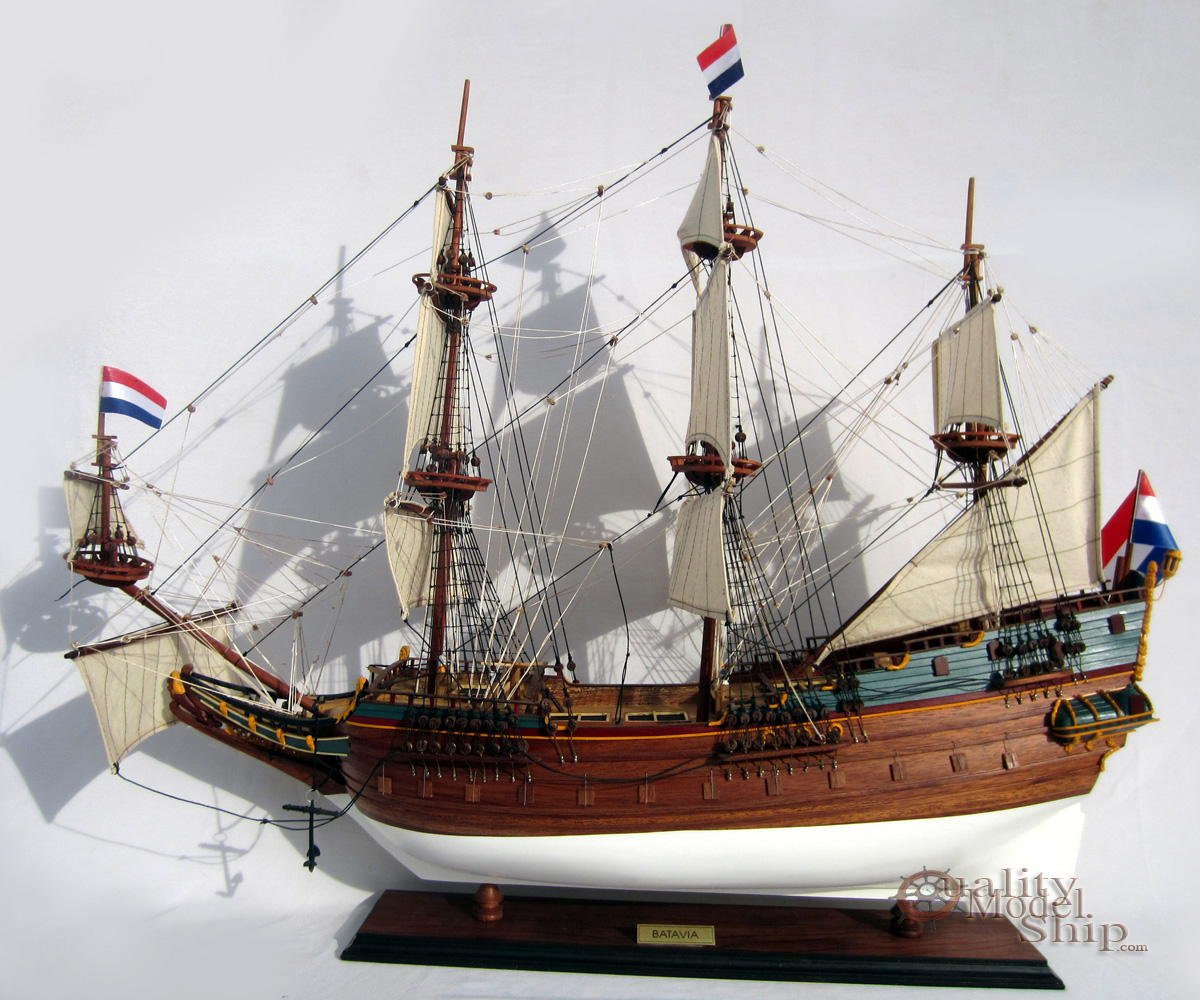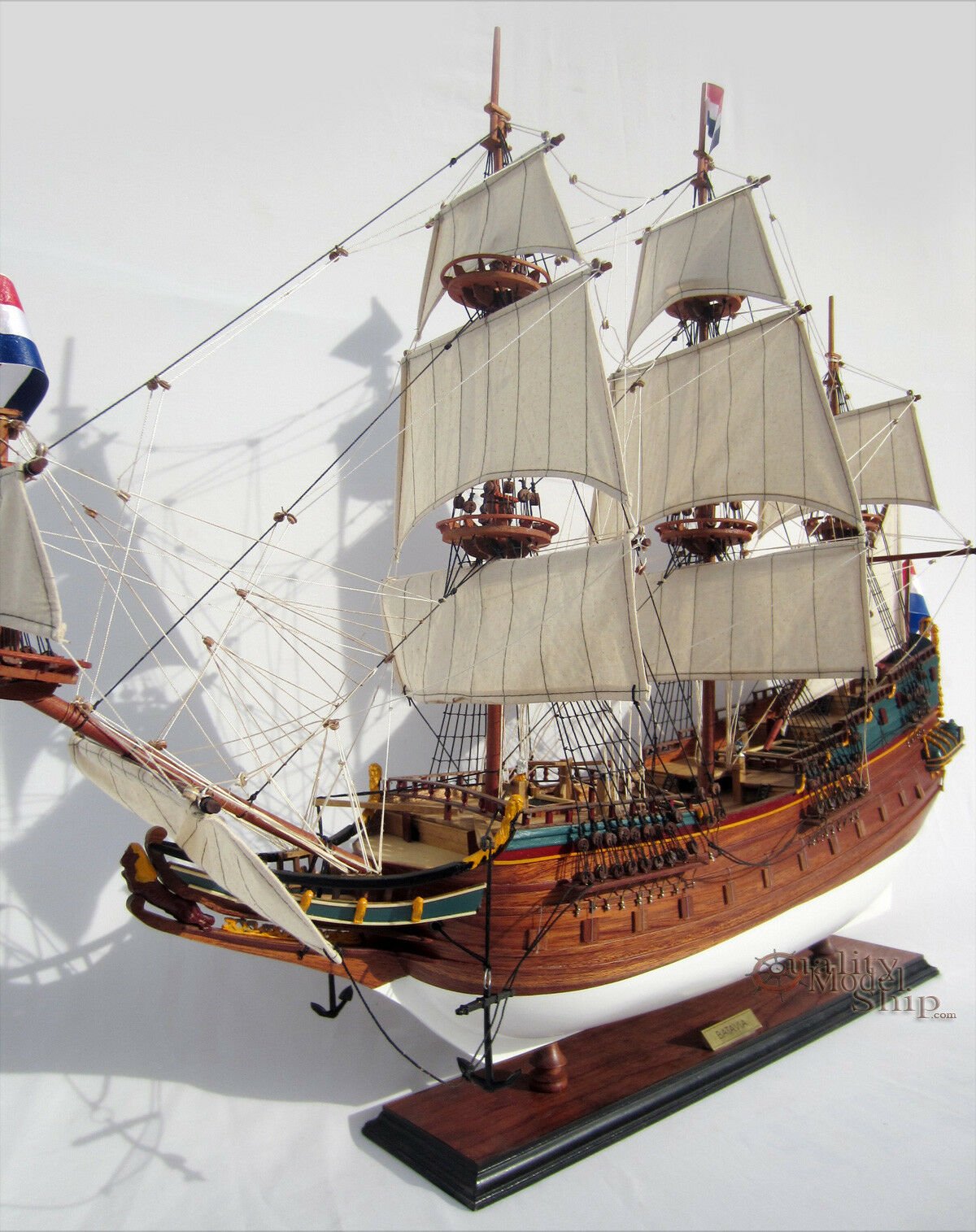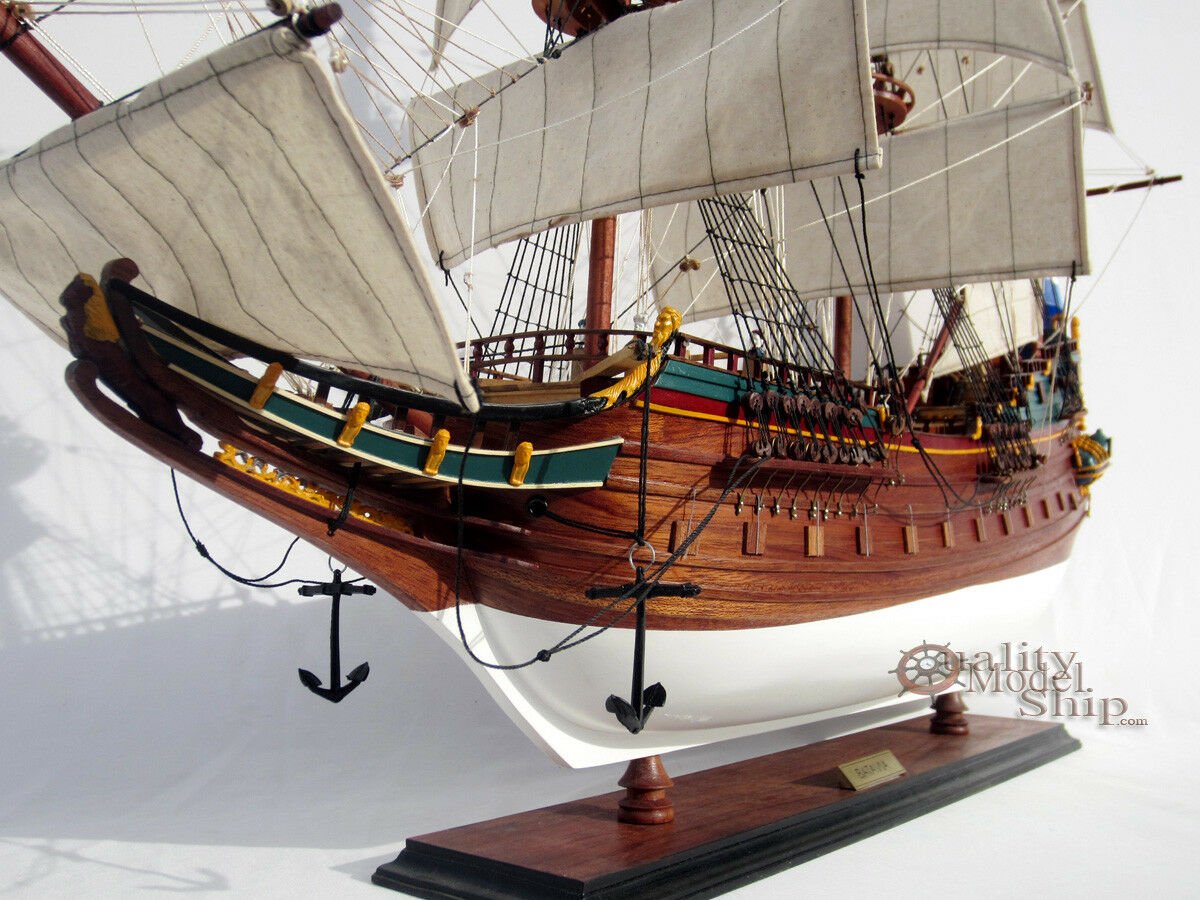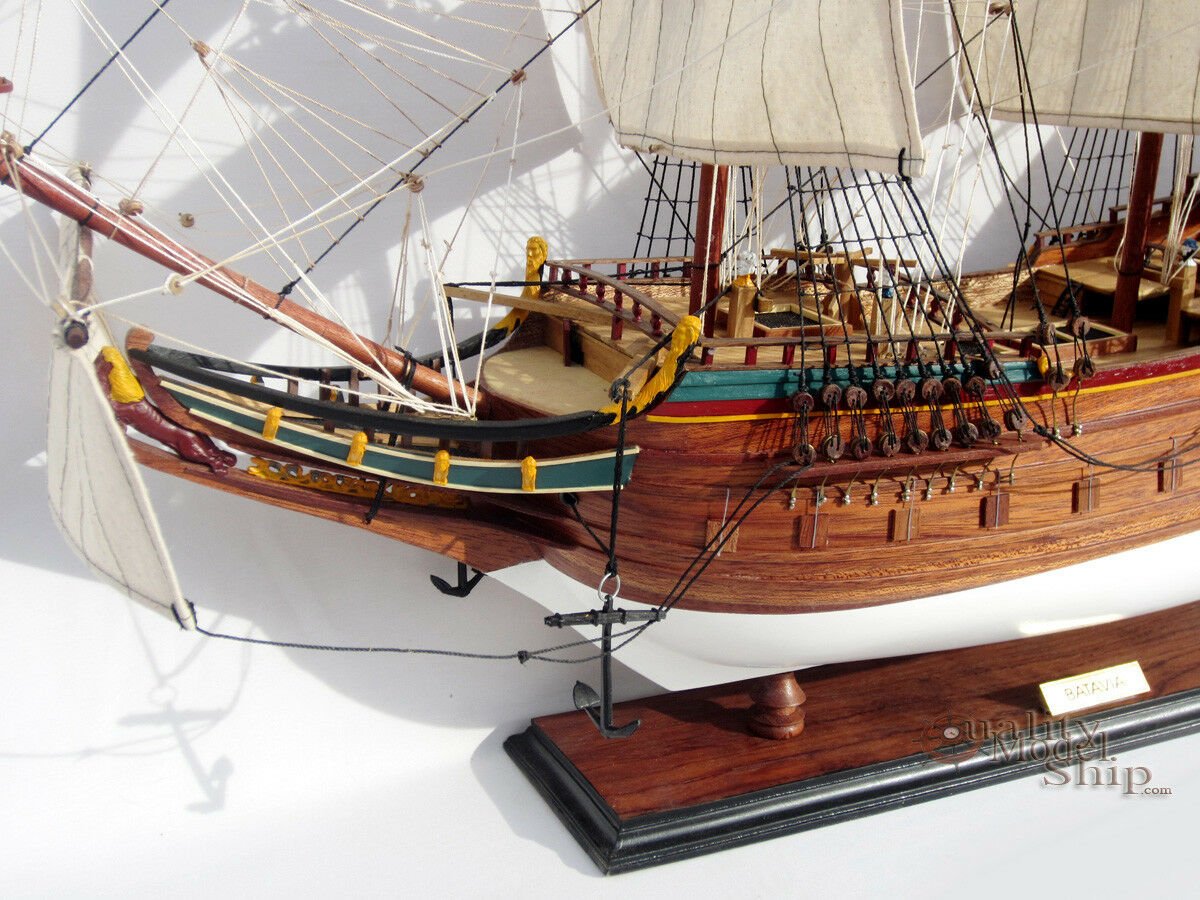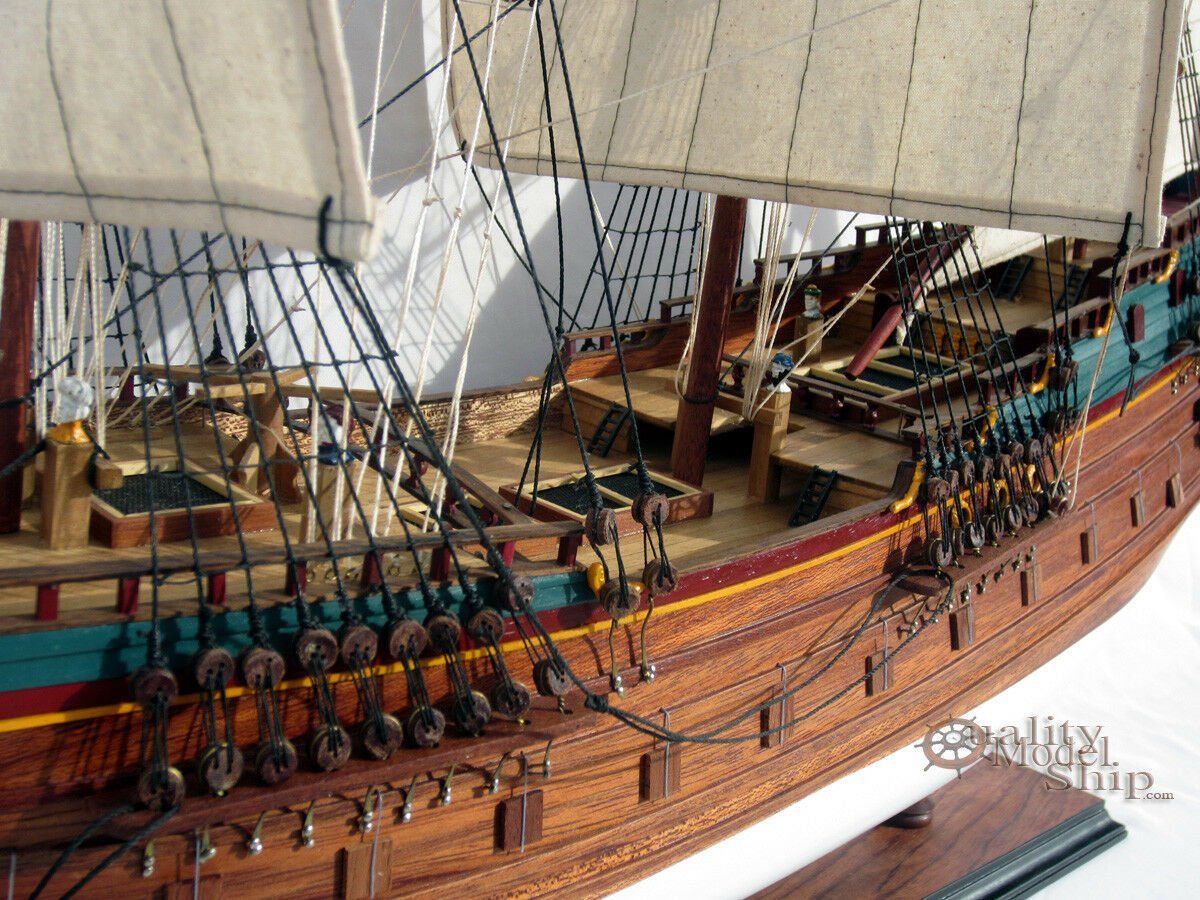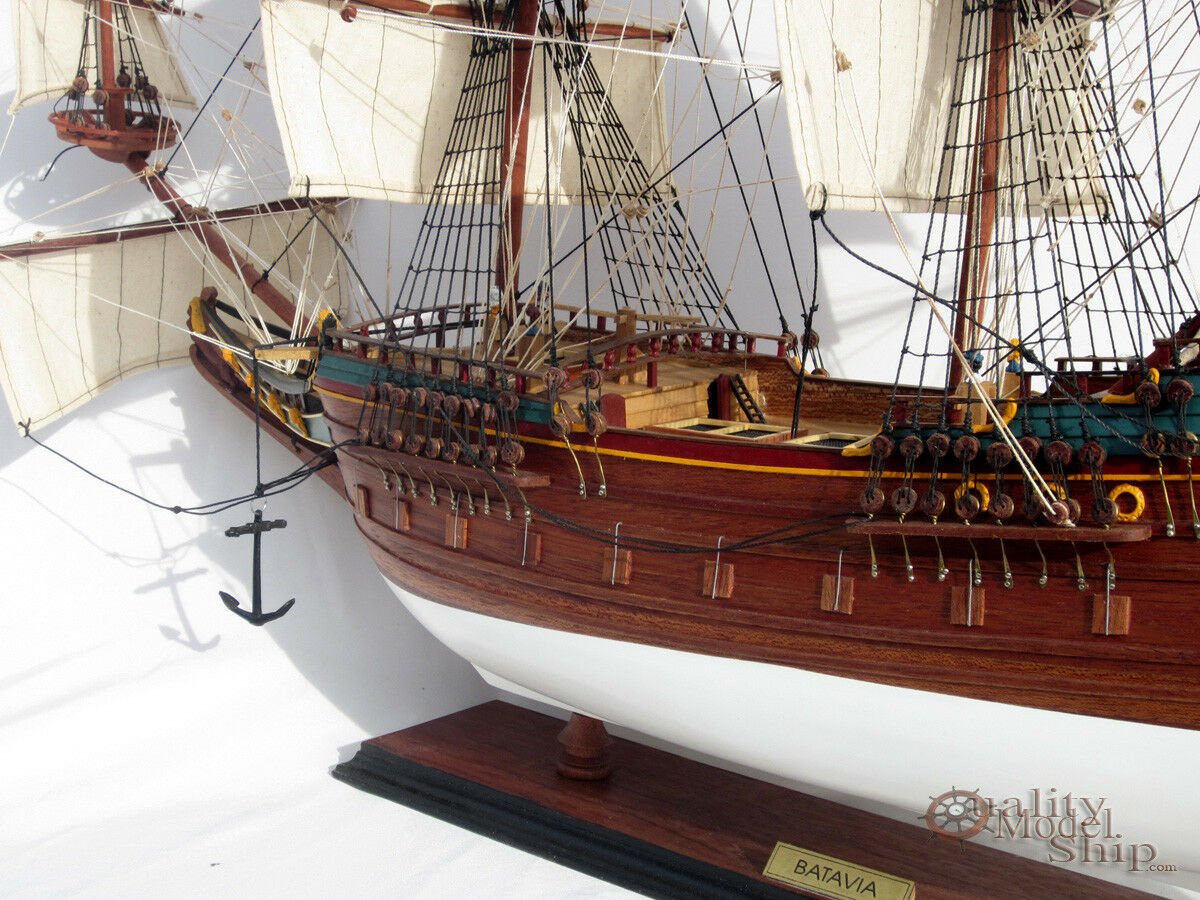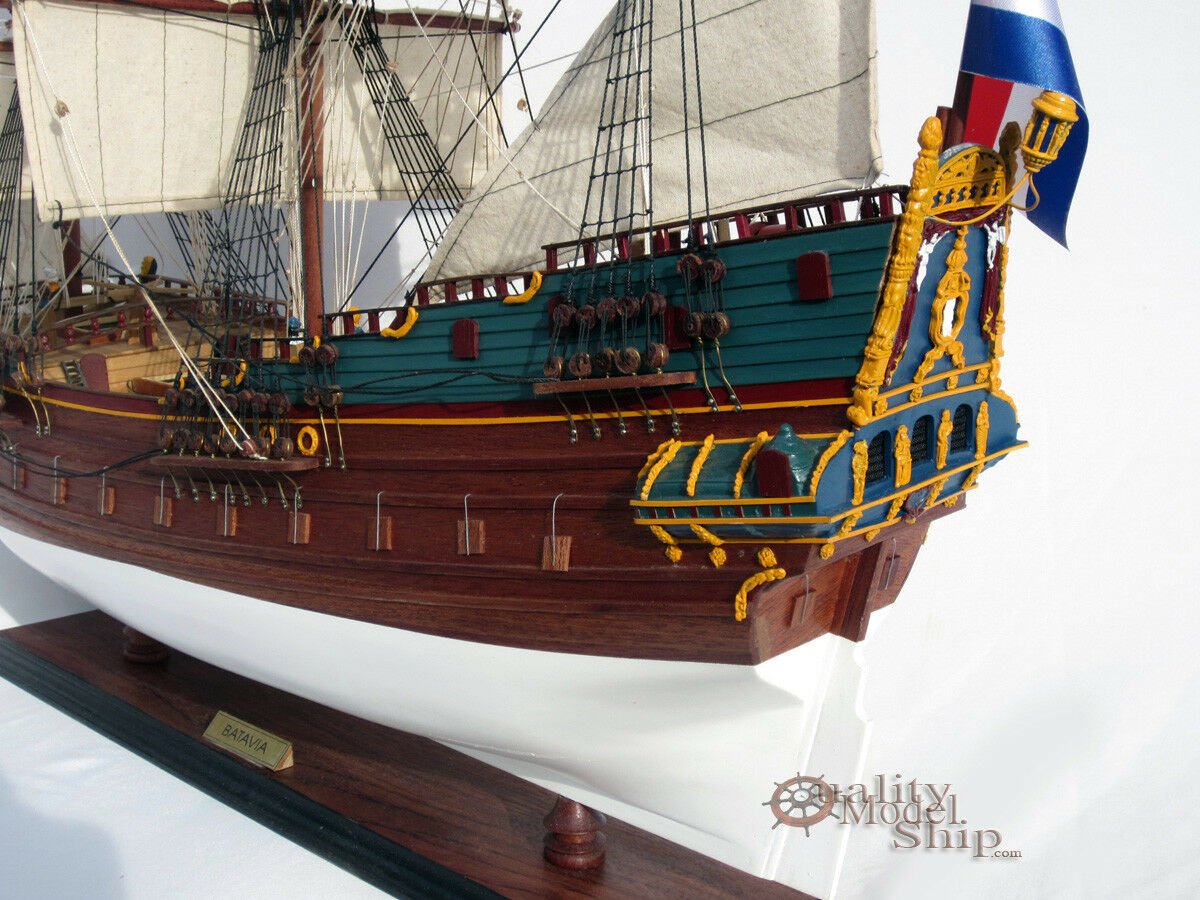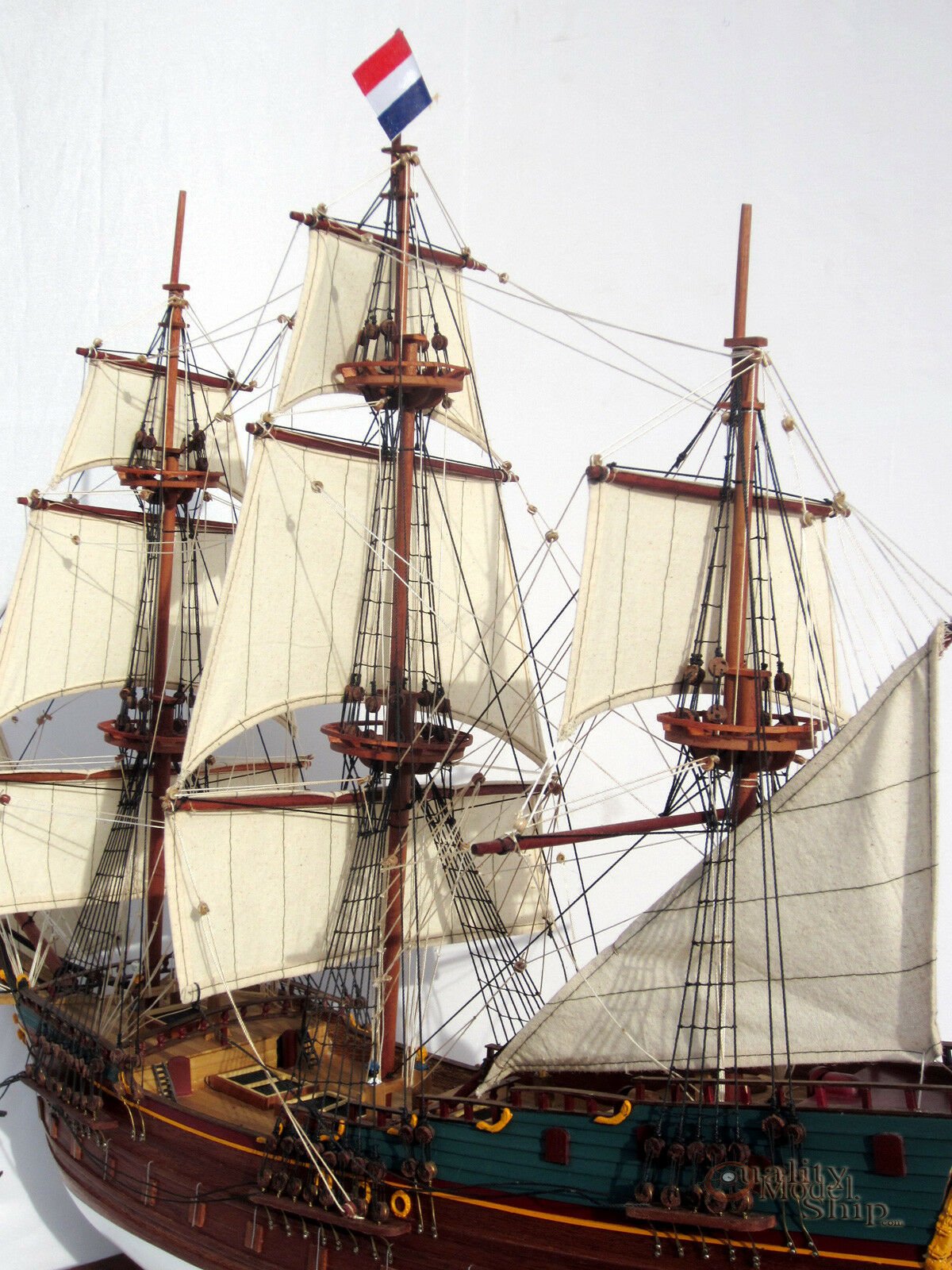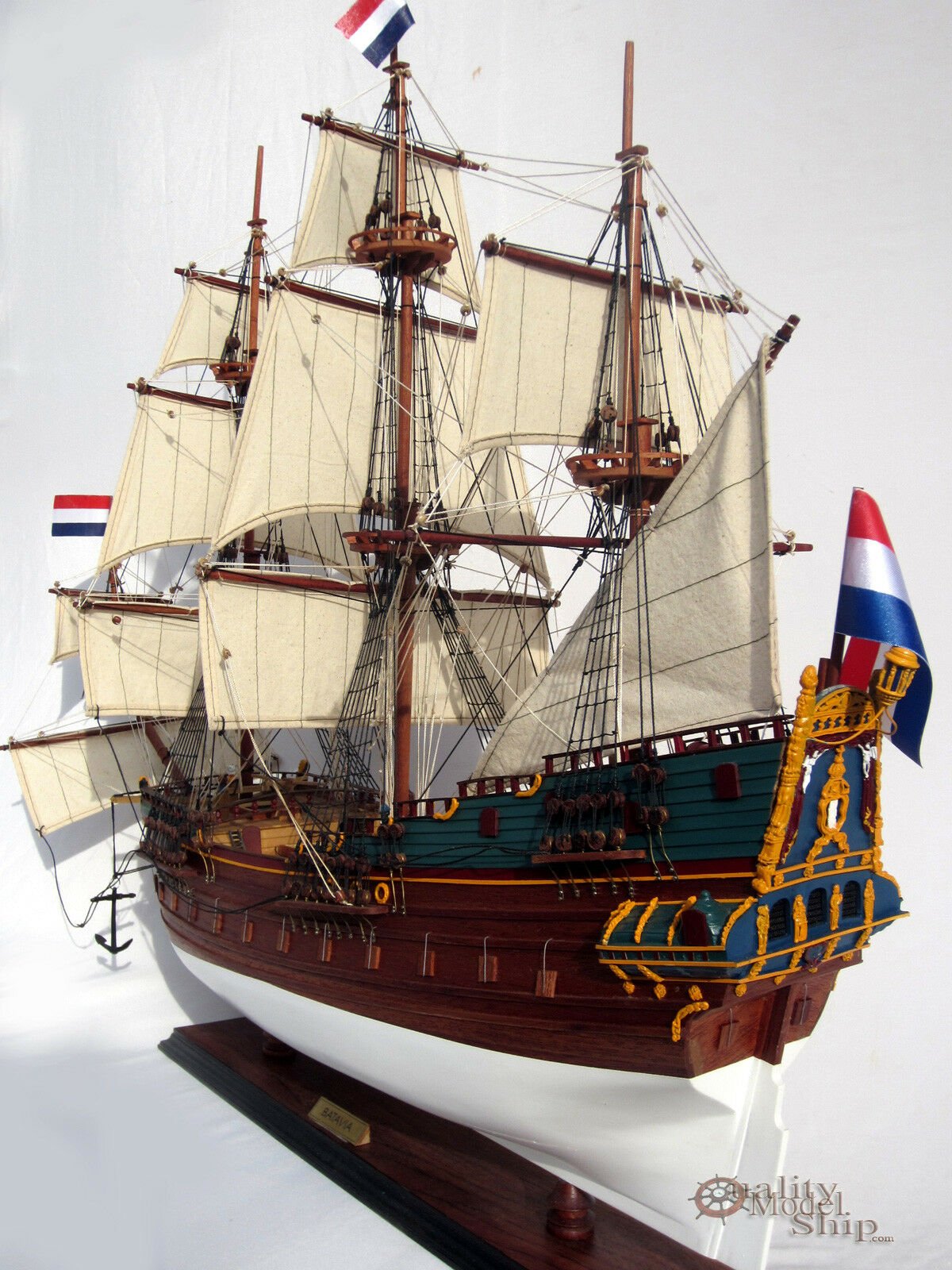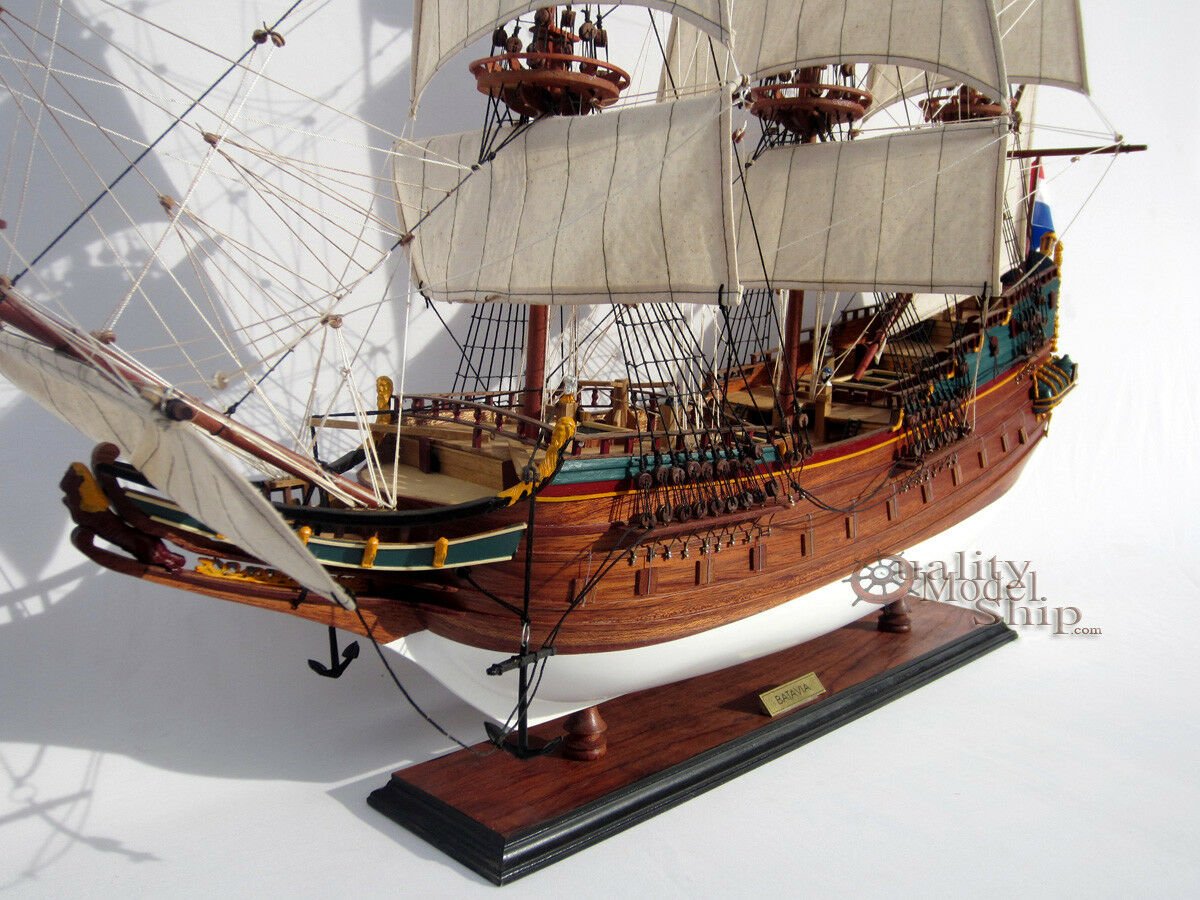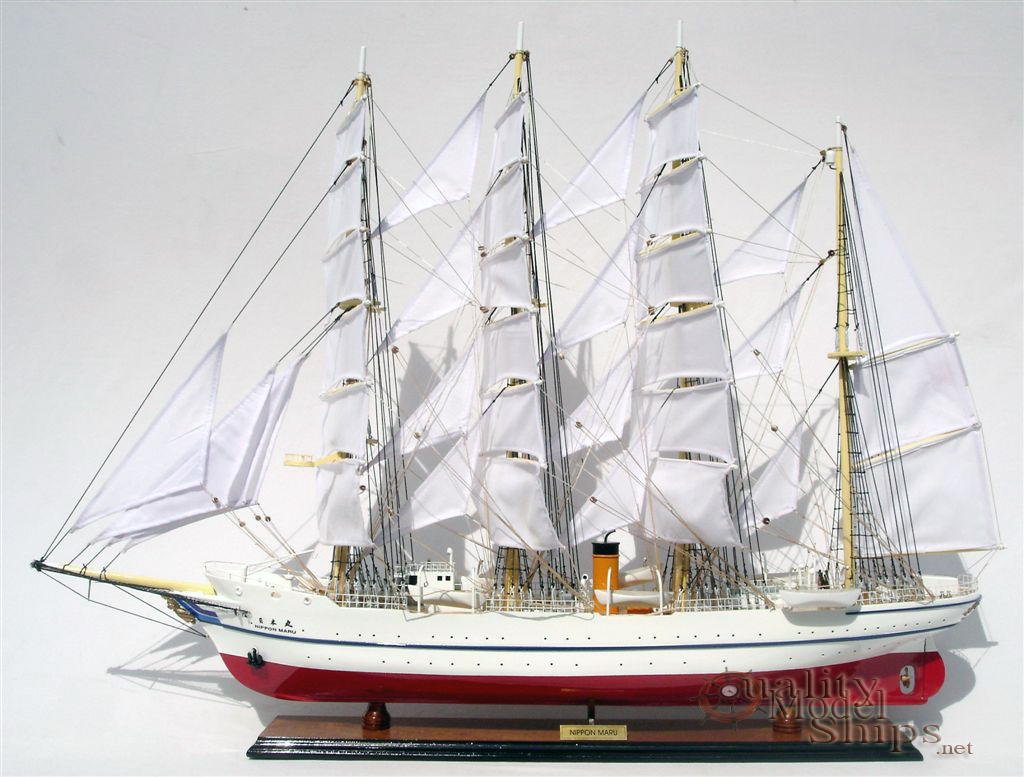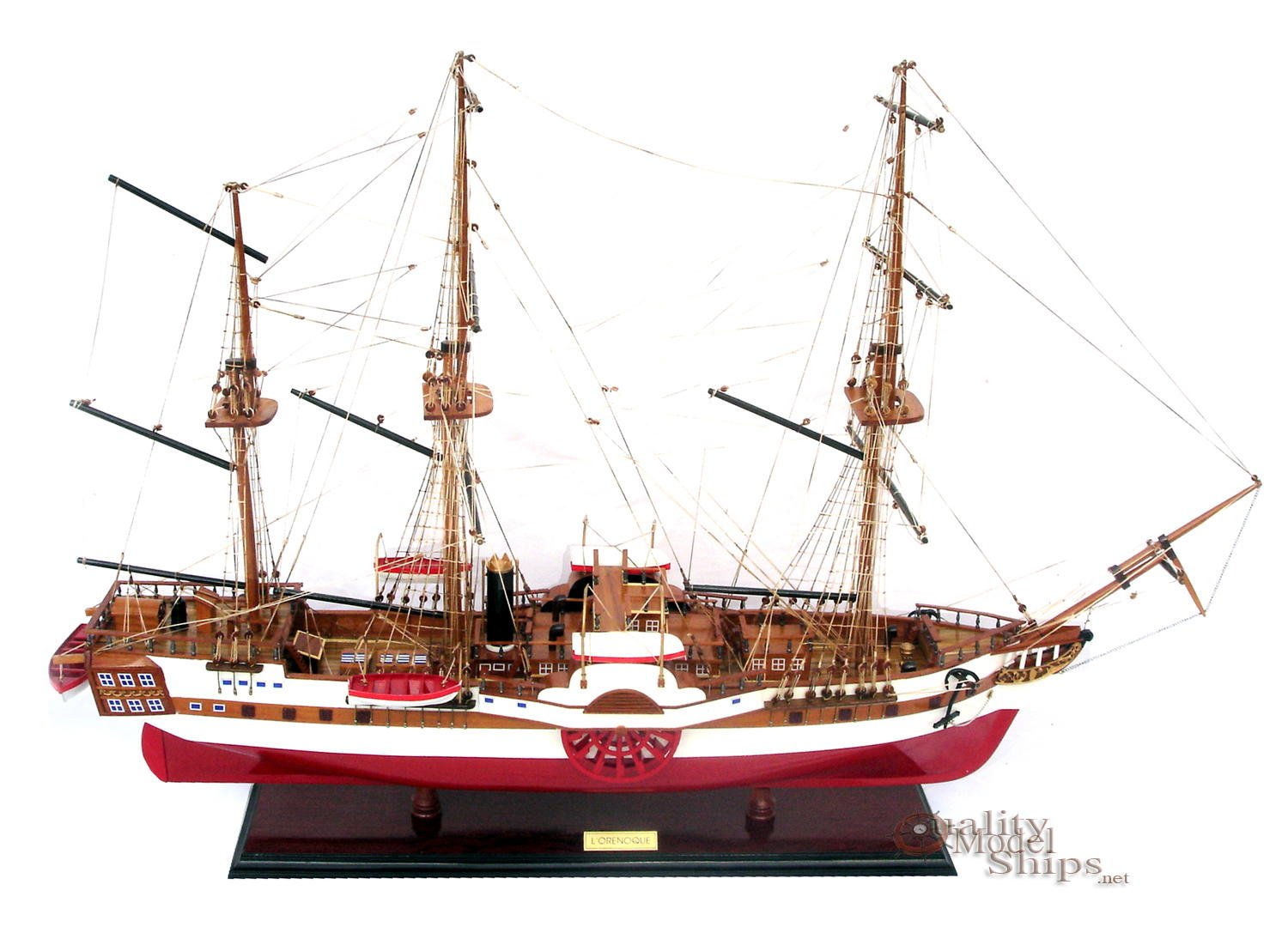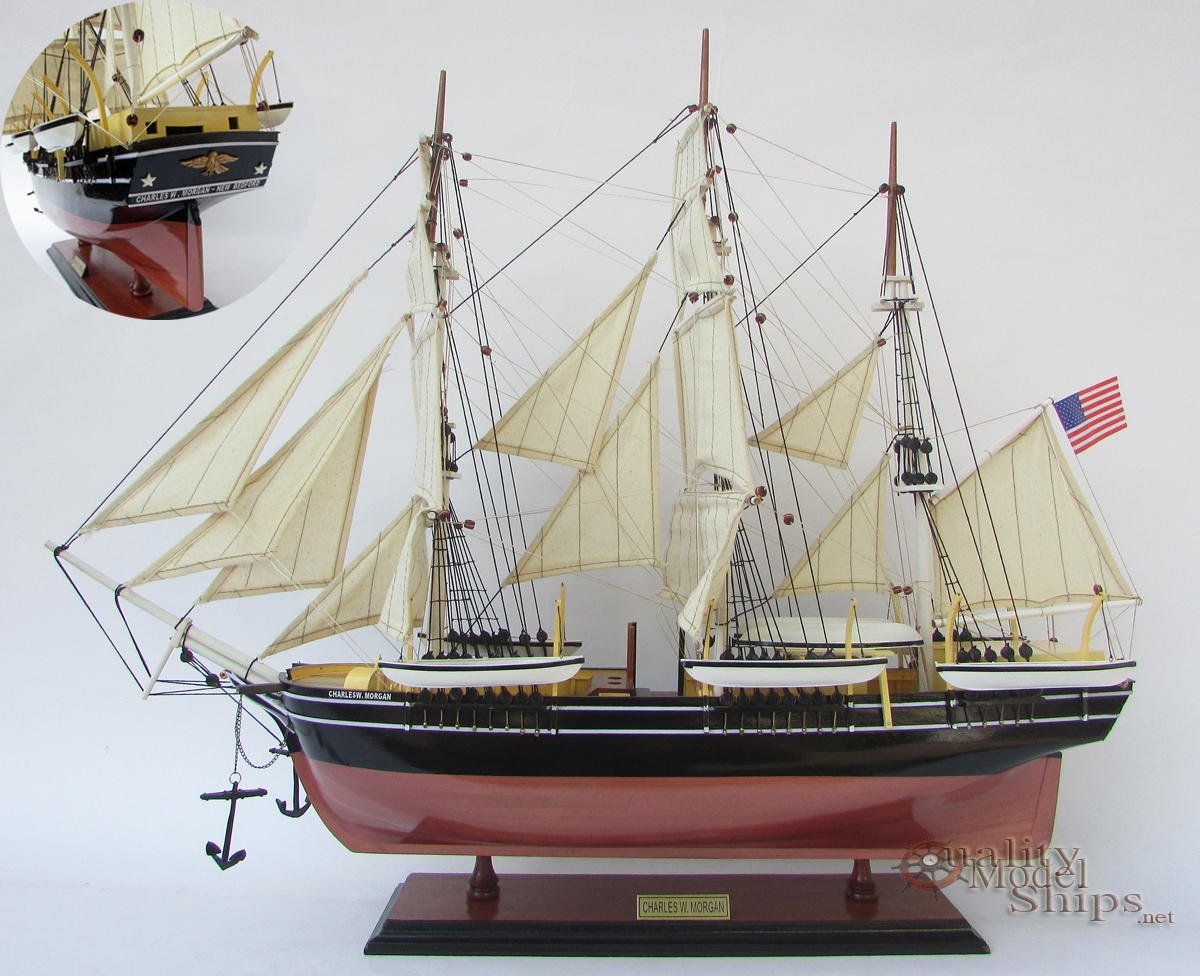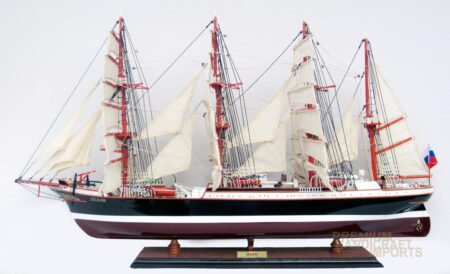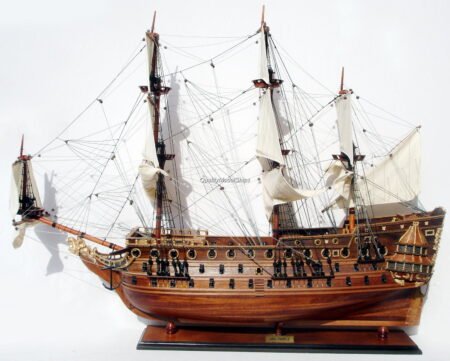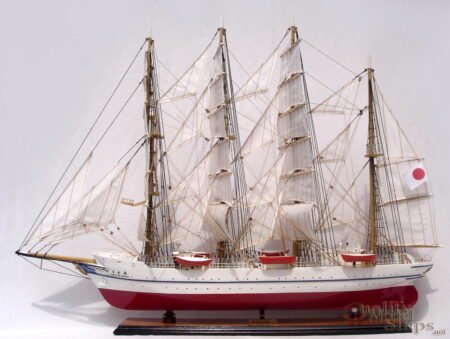| Content | • The model is 100% scratch built with planks-on-frame construction method. The hull is made of combination exotic wood stained that you can see the natural wood grains. The hull below waterline is white painted. The masts are full-rigged with full sails. It takes hundreds of hours to finish this model by skillful master craftsmen.
• The ornaments such as cannons, anchors, lamps are metal.
• Model is fully assembled and ready to display. The base included with the brass nameplate as show pictures.
• Dimensions approximate 36.61L x 7.48W x 29.53H (inch) or 93L x 19W x 75H (cm)
• Buyer from Alaska, Puerto Rico, Hawaii or overseas, please contact us for shipping cost.
HISTORY
Batavia (Dutch pronunciation: [baːˈtaːviaː]) was a ship of the Dutch East India Company (VOC). It was built in Amsterdam in 1628, and armed with 24 cast-iron cannons and a number of bronze guns. Batavia was shipwrecked on her maiden voyage, and was made famous by the subsequent mutiny and massacre that took place among the survivors. A twentieth-century replica of the ship is also called the Batavia and can be visited in Lelystad, Netherlands.
Mutiny on the Batavia
Departure and voyage
On 27 October 1628, the newly built Batavia, commissioned by the Dutch East India Company, sailed from Texel for the Dutch East Indies, to obtain spices. It sailed under commander and opperkoopman (upper- or senior merchant) Francisco Pelsaert, with Ariaen Jacobsz serving as skipper. These two had previously encountered each other in Surat, India. Although some animosity had developed between them there, it is not known whether Pelsaert even remembered Jacobsz when he boarded Batavia. Also on board was the onderkoopman (under- or junior merchant) Jeronimus Cornelisz, a bankrupt pharmacist from Haarlem who was fleeing the Netherlands, in fear of arrest because of his heretical beliefs associated with the painter Johannes van der Beeck, also known as Torrentius.
During the voyage, Jacobsz and Cornelisz conceived a plan to take the ship, which would allow them to start a new life somewhere, using the huge supply of trade gold and silver then on board. After leaving Cape Town, where they had stopped for supplies, Jacobsz deliberately steered the ship off course, away from the rest of the fleet. Jacobsz and Cornelisz had already gathered a small group of men around them and arranged an incident from which the mutiny was to ensue. This involved molesting a high-ranking young female passenger, Lucretia Jans, in order to provoke Pelsaert into disciplining the crew. They hoped to paint his discipline as unfair and recruit more members out of sympathy. However, the woman was able to identify her attackers. The mutineers were then forced to wait until Pelsaert made arrests, but he never acted, as he was suffering from an unknown illness.
Shipwreck
On 4 June 1629 the ship struck Morning Reef near Beacon Island (28°29′25″S 113°47′36″ECoordinates: 28°29′25″S 113°47′36″E), part of the Houtman Abrolhos off the Western Australian coast. Of the 322 aboard, most of the passengers and crew managed to get ashore, although 40 people drowned. The survivors, including all the women and children, were then transferred to nearby islands in the ship's longboat and yawl. An initial survey of the islands found no fresh water and only limited food (sea lions and birds). Pelsaert realised the dire situation and decided to search for water on the mainland.
A group comprising Captain Jacobsz, Francisco Pelsaert, senior officers, a few crewmembers, and some passengers left the wreck site in a 30-foot (9.1 m) longboat (a replica of which has also been made), in search of drinking water. After an unsuccessful search for water on the mainland, they abandoned the other survivors and headed north in a danger-fraught voyage to the city of Batavia, now known as Jakarta. This journey, which ranks as one of the greatest feats of navigation in open boats, took 33 days and, extraordinarily, all aboard survived.
After their arrival in Batavia, the boatswain, a man named Jan Evertsz, was arrested and executed for negligence and "outrageous behavior" before the loss of the ship (he was suspected to have been involved). Jacobsz was also arrested for negligence, although his position in the potential mutiny was not guessed by Pelsaert.
Batavia's Governor General, Jan Coen, immediately gave Pelsaert command of the Sardam to rescue the other survivors, as well as to attempt to salvage riches from the Batavia's wreck. He arrived at the islands two months after leaving Batavia, only to discover that a bloody mutiny had taken place amongst the survivors, reducing their numbers by at least a hundred.
Murders
Jeronimus Cornelisz, who had been left in charge of the survivors, was well aware that if that party ever reached the port of Batavia, Pelsaert would report the impending mutiny, and his position in the planned mutiny might become apparent. Therefore, he made plans to hijack any rescue ship that might return and use the vessel to seek another safe haven. Cornelisz even made far-fetched plans to start a new kingdom, using the gold and silver from the wrecked Batavia. However, to carry out this plan, he first needed to eliminate possible opponents.
Cornelisz's first deliberate act was to have all weapons and food supplies commandeered and placed under his control. He then moved a group of soldiers, led by Wiebbe Hayes, to nearby West Wallabi Island, under the false pretence of searching for water. They were told to light signal fires when they found water and they would then be rescued. Convinced that they would be unsuccessful, he then left them there to die.
Cornelisz then had complete control. The remaining survivors would face two months of unrelenting butchery and savagery.
With a dedicated band of murderous young men, Cornelisz began to systematically kill anyone he believed would be a problem to his reign of terror, or a burden on their limited resources. The mutineers became intoxicated with killing, and no one could stop them. They needed only the smallest of excuses to drown, bash, strangle or stab to death any of their victims, including women and children.
Cornelisz never committed any of the murders himself, although he tried and failed to poison a baby (who was eventually strangled). Instead, he used his powers of persuasion to coerce others into doing it for him, firstly under the pretence that the victim had committed a crime such as theft. Eventually, the mutineers began to kill for pleasure, or simply because they were bored. He planned to reduce the island's population to around 45 so that their supplies would last as long as possible. In total, his followers murdered at least 110 men, women, and children.
Rescue
Although Cornelisz had left the soldiers, led by Wiebbe Hayes, to die, they had in fact found good sources of water and food on their islands. Initially, they were unaware of the barbarity taking place on the other islands and sent pre-arranged smoke signals announcing their finds. However, they soon learned of the massacres from survivors fleeing Cornelisz' island. In response, the soldiers devised makeshift weapons from materials washed up from the wreck. They also set a watch so that they were ready for the mutineers, and built a small fort out of limestone and coral blocks.
Cornelisz seized on the news of water on the other island, as his own supply was dwindling and the continued survival of the soldiers threatened his own success. He went with his men to try to defeat the soldiers marooned on West Wallabi Island. However, the trained soldiers were by now much better fed than the mutineers and easily defeated them in several battles, eventually taking Cornelisz hostage. The mutineers who escaped regrouped under a man named Wouter Loos and tried again, this time employing muskets to besiege Hayes' fort and almost defeated the soldiers.
But Wiebbe Hayes' men prevailed again, just as Pelsaert arrived. A race to the rescue ship ensued between Cornelisz's men and the soldiers. Wiebbe Hayes reached the ship first and was able to present his side of the story to Pelsaert. After a short battle, the combined force captured all of the mutineers.
Aftermath
Pelsaert decided to conduct a trial on the islands, because the Saardam on the return voyage to Batavia would have been overcrowded with survivors and prisoners. After a brief trial, the worst offenders were taken to Seal Island and executed. Cornelisz and several of the major mutineers had both hands chopped off before being hanged. Wouter Loos and a cabin boy, considered only minor offenders, were marooned on mainland Australia, never to be heard of again. Reports of unusually light-skinned Aborigines in the area by later British settlers have been suggested as evidence that the two men might have been adopted into a local Aboriginal clan. Some amongst the Amangu people of the mainland have a blood group specific to Leyden, in Holland. However, numerous other European shipwreck survivors, such as those from the wreck of the Zuytdorp in the same region in 1712, may also have had such contact with indigenous inhabitants.
The remaining mutineers were taken to Batavia for trial. Five were hanged, while several others were flogged. Cornelisz's second in command, Jacop Pietersz, was broken on the wheel, the most severe punishment available at the time.
Captain Jacobsz, despite being tortured, did not confess to his part in planning the mutiny and escaped execution due to lack of evidence. What finally became of him is unknown. It is suspected that he died in prison in Batavia.
A board of inquiry decided that Pelsaert had exercised a lack of authority and was therefore partly responsible for what had happened. His financial assets were seized, and he died a broken man within a year.
On the other hand, the common soldier Wiebbe Hayes was hailed as a hero. The Dutch East India Company promoted him to sergeant, and later to lieutenant, which increased his salary fivefold.
Of the original 341 people on board the Batavia, only 68 made it to the port of Batavia.
Wreckage, discovery and recovery
During Admiralty surveys of the Abrolhos Islands on the north-west coast in April 1840, Captain Stokes of HMS Beagle reported that:
On the south west point of an island the beams of a large vessel were discovered, and as the crew of the Zeewyk, lost in 1728, reported having seen a wreck of a ship on this part, there is little doubt that the remains were those of the Batavia, Commodore Pelsart, lost in 1629. We in consequence named our temporary anchorage Batavia Road, and the whole group Pelsart Group.
However, Stokes appears to have confused the wreck of the Zeewyk for that of the Batavia. In the 1950s, historian Henrietta Drake-Brockman, who had learnt of the story due to her association with the children of the Abrolhos Islands guano merchant F. C. Broadhurst, son of Charles Edward Broadhurst, argued from extensive archival research and translations by E. D. Drok, that the wreck must lie in the Wallabi Group of islands. Surveyor Bruce Melrose and diving journalist Hugh Edwards agreed with the theory. In association with Drake-Brockman, Edwards organised a number of search expeditions near Beacon Island in the early 1960s and narrowly missed locating the site. After Edwards provided his research to them, and after being led to the place by Abrolhos rock lobster-fisherman Dave Johnson (who had seen an anchor from his boat while setting lobster pots), on 4 June 1963 Max and Graham Cramer with Greg Allen became the first to dive on the site. Its location, together with those of the VOC ship Vergulde Draeck (Gilt Dragon) and the English East India Company Triall (Tryal), in the early 1960s, led to the formation of the Departments of Maritime Archaeology and Materials Conservation and Restoration at the Western Australian Museum.
In the period 1970 through to 1974, under the leadership of maritime archaeologist Jeremy Green of the Western Australian Museum, some of the cannon from the Batavia wreck, an anchor, and many artifacts were salvaged, including timbers from the port side of the ship's stern. These were then conserved by the Museum's conservation laboratories under the leadership of Colin Pearson and his successors Neil North and Ian MacLeod. Monitoring and treatment of the timbers is ongoing and is under the leadership of Ian Godfrey and Vicki Richards.
In order to facilitate the monitoring and any future treatment, the hull timbers were erected on a steel frame designed and erected by Geoff Kimpton, a member of Green's staff. The design, and that of a stone arch, or portico, which was also raised from the seabed, is such that individual components can be removed for treatment without affecting those adjacent, or the exhibit as a whole.
In 1972, the Netherlands transferred all rights to Dutch shipwrecks on the Australian coasts to Australia. Some of the items, including human remains, which were excavated, are now on display in the Western Australian Museum – Shipwreck Galleries in Fremantle, Australia. Others are held by the Western Australian Museum, Geraldton. These two museums presently share the remains: a replica stone arch is held in The Western Australian Museum – Shipwreck Galleries, which was intended to serve as a stone welcome arch for the city of Batavia and the actual stone arch is held in the Western Australian Museum, Geraldton; the original timbers from the ship's hull are held at the Western Australian Museum – Shipwreck Galleries. While a great deal of materials have been recovered from the wreck-site, the majority of the cannons and anchors have been left in-situ. As a result, the wreck remains one of the premier dive sites on the West Australian coast and is part of the museum's wreck trail, or underwater "museum-without-walls" concept.
Replica
A replica of the Batavia was built at the Bataviawerf (Batavia shipyard) in Lelystad in the Netherlands. The project lasted from 1985 to 7 April 1995, and was conducted as an employment project for young people under master-shipbuilder Willem Vos. The shipyard is currently reconstructing another 17th century ship. In contrast to the merchant ship Batavia, Michiel de Ruyters' flagship, the Zeven Provinciën, is a ship of the line.
The Batavia replica was built with traditional materials, such as oak and hemp, and using the tools and methods of the time of the original ship's construction. For the design, good use was made of the remains of the original ship in Fremantle (and of the Vasa in Stockholm), as well as historical sources, such as 17th century building descriptions (actual building plans weren't made at the time), and prints and paintings by artists (who, at the time, generally painted fairly true to nature), of similar ships.
On 25 September 1999, the new Batavia was transported to Australia by barge, and moored at the National Maritime Museum in Sydney. In 2000, Batavia was the flagship for the Dutch Olympic Team during the 2000 Olympic Games. During its stay in Australia, the ship was towed to the ocean once, where it sailed on its own. On 12 June 2001, the ship returned to the Bataviawerf in Lelystad, where it remains on display to visitors. On the evening of 13 October 2008, a fire ripped through the shipyard. The museum's workshops, rigging loft, block shop, offices, part of a restaurant and the entire hand-sewn suit of sails of the ship were lost to the blaze, however the replica of "De Zeven Provinciën" nearby was undamaged. The moored Batavia was never in danger.
Return/ Exchange Policy
• For some reasons if you wish to return the item, please consider not to open the item out of the wooden crate or open the item out of the styrofoam. You can open the carton box, lift up the whole wooden crate and check the models that are packed in wooden crate. For the items are packed in solid styrofoam, you can open the carton box, lift up the top part (styrofoam lid) and check the model. Please do not cut any strips or take the model out of the wooden crate or out of the styrofoam. It is very risky of damages to the item when you return if you open or remove the item out of the wooden crate or the styrofoam. We only accept and refund in full when the model return in good shape.
• Returned or exchanged products must be in brand-new, original condition, and have all original packaging, materials, and accessories .
• Buyer pays return shipping.
• 15% restocking fee might apply.
| • The model is 100% scratch built with planks-on-frame construction method. The hull is made of wood and painted. The masts are full-rigged with full sails. It takes hundreds of hours to finish this model by skillful master craftsmen.
• The ornaments such anchors, chains, steering wheel are metal.
• Model is fully assembled and ready to display. The base included with the brass nameplate as show pictures.
• Dimensions overall approximate 37.79L x 6.30W x 24.80H (inch) 96L x 16W x 63H (cm)
• Buyer from Alaska, Puerto Rico or Hawaii, please contact us for extra shipping cost.
• International buyer pays any duty/ import tax.
Return/ Exchange Policy
• For some reasons if you wish to return the item, please consider not to open the item out of the wooden crate or open the item out of the styrofoam. You can open the carton box, lift up the whole wooden crate and check the models that are packed in wooden crate. For the items are packed in solid styrofoam, you can open the carton box, lift up the top part (styrofoam lid) and check the model. Please do not cut any strips or take the model out of the wooden crate or out of the styrofoam. It is very risky of damages to the item when you return if you open or remove the item out of the wooden crate or the styrofoam. We only accept and refund in full when the model return in good shape.
• Returned or exchanged products must be in brand-new, original condition, and have all original packaging, materials, and accessories .
• Buyer pays return shipping.
• 15% restocking fee might apply.
| • The model is 100% scratch built with planks-on-frame construction method. The hull is made of combination exotic wood and painted. The masts are full rigged with linen sails. It take hundreds of hours to finish this model by skillful master craftsmen.
• The ornaments such as anchor, propeller, steering wheel are metal.
• Model is fully assembled and ready to display. The base included with the brass nameplate as show pictures.
• Dimensions approximate 36.61L x 6.69W x 26.77H (inch) or 93L x 17W x 68H (cm)
• Buyer from Alaska, Puerto Rico or Hawaii, please contact us for extra shipping cost.
• Item ship from Houston Texas by Standard shipping USPS/ UPS/ FedEx ground
• International buyer pays any duty/ import tax if any.
Return/ Exchange Policy
• For some reasons if you wish to return the item, please consider not to open the item out of the wooden crate or open the item out of the styrofoam. You can open the carton box, lift up the whole wooden crate and check the models that are packed in wooden crate. For the items are packed in solid styrofoam, you can open the carton box, lift up the top part (styrofoam lid) and check the model. Please do not cut any strips or take the model out of the wooden crate or out of the styrofoam. It is very risky of damages to the item when you return if you open or remove the item out of the wooden crate or the styrofoam. We only accept and refund in full when the model return in good shape.
• Returned or exchanged products must be in brand-new, original condition, and have all original packaging, materials, and accessories
• Buyer pays return shipping.
• 15% restocking fee might apply.
| • The model is 100% scratch built with planks-on-frame construction
method. The hull is made of combination exotic wood and painted. The
masts are full rigged. It take hundreds of hours to
finish this model by skillful master craftsmen.
• The ornaments such as anchor, propeller, steering wheel are metal.
• Model is fully assembled and ready to display. The base included with the brass nameplate as show pictures.
• Dimensions approximate 37.79L x 10.23W x 27.55H (inch) or 96L x 26W x 70H (cm)
• Buyer from Alaska, Puerto Rico or Hawaii, please contact us for extra shipping cost.
• Item ship from Houston Texas by Standard shipping USPS/ UPS/ FedEx ground
• International buyer pays any duty/ import tax if any.
Return/ Exchange Policy
• For some reasons if you wish to return the item, please consider not to open the item out of the wooden crate or open the item out of the styrofoam. You can open the carton box, lift up the whole wooden crate and check the models that are packed in wooden crate. For the items are packed in solid styrofoam, you can open the carton box, lift up the top part (styrofoam lid) and check the model. Please do not cut any strips or take the model out of the wooden crate or out of the styrofoam. It is very risky of damages to the item when you return if you open or remove the item out of the wooden crate or the styrofoam. We only accept and refund in full when the model return in good shape.
• Returned or exchanged products must be in brand-new, original condition, and have all original packaging, materials, and accessories
• Buyer pays return shipping.
| • The model is 100% scratch built with planks-on-frame construction method. This model is made from wood and then painted all black. The model is ready for display which comes with a pirate flag, a brass nameplate and the base. The masts are full-rigged with full sails. It takes hundreds of hours to finish this model by skillful master craftsmen.
• The ornaments such as cannons, anchors, lamps are metal.
• Dimensions approximate L20" x W6" x H18" or 50L x 15W x 45H (cm)
• Buyer from Alaska, Puerto Rico, Hawaii or overseas, please contact us for shipping cost.
• For some reasons if you wish to return the item, please consider not to open the item out of the wooden crate or open the item out of the styrofoam. You can open the carton box, lift up the whole wooden crate and check the models that are packed in wooden crate. For the items are packed in solid styrofoam, you can open the carton box, lift up the top part (styrofoam lid) and check the model. Please do not cut any strips or take the model out of the wooden crate or out of the styrofoam. It is very risky of damages to the item when you return if you open or remove the item out of the wooden crate or the styrofoam. We only accept and refund in full when the model return in good shape.
• Returned or exchanged products must be in brand-new, original condition, and have all original packaging, materials, and accessories .
• Buyer pays return shipping.
• 15% restocking fee might apply.
| • The model is 100% scratch built with planks-on-frame construction method. The hull is made of combination exotic wood and painted. The masts are full-rigged with full sails. It takes hundreds of hours to finish this model by skillful master craftsmen.
• The ornaments such as cannons, anchors, lamps are metal.
• Model is fully assembled and ready to display. The base is included with the brass nameplate as show pictures.
• Dimensions overall approximate 26.37L x 7.87W x 26.37H (inch) or 67L x 20W x 67H (cm)
• Buyer from Alaska, Puerto Rico or Hawaii, please contact us for extra shipping cost.
• International buyer pays any duty/ import tax.
|
